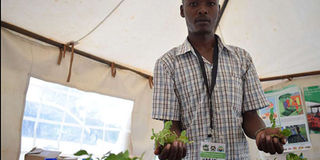Youth find wealth in potato seeds

Harun Kimutai showcasing potato seedlings at Bukura Agricultural College, Kakamega County. PHOTO| ELIZABETH OJINA| NMG
What you need to know:
- Kimutai, whose group was among several others at the event that supported 800 youths from counties in western, recounts that he saw the good returns from his father’s seed multiplication venture.
- They now multiply the certified seeds by planting them in a spacing of 75cm by 30cm in well-tilled and drained soils
- Selected seed tubers are then stored in diffused light stores that have ample aeration
Donning a checked brown shirt, Harun Kimutai is sorting potato seedlings when Seeds of Gold meets him at the Bukura Agricultural College in Kakamega during a youth expo.
Kimutai, who was at the recent exhibition dubbed Western Kenya Youth in Agribusiness Conference organised by the college, Kakamega, Bungoma and Siaya county governments and supported by GIZ, had over 1,000 Yunica potato variety seedlings to market to farmers.
The secretary of Oldoldol Youth Group based in Lessos, Nandi Hills, said they sell the seedlings at Sh10 each.
“We normally get certified seeds and bulk them for farmers,” he said, noting the group started in 2016 with 10 members as soccer club before venturing into agribusiness.
Kimutai, whose group was among several others at the event that supported 800 youths from counties in western, recounts that he saw the good returns from his father’s seed multiplication venture and shared the idea with other members who adopted it.
“We then drafted a business plan and shared it with the county government. The International Potato Centre then trained us on seed multiplication in April, 2016. We, soon after, received eight 50kg bags of certified seed for multiplication.”
The training involved seed multiplication, propagation of potatoes as well as value addition.
They now multiply the certified seeds by planting them in a spacing of 75cm by 30cm in well-tilled and drained soils, besides growing potatoes separately.
“The seeds are planted in 10cm to 15cm depth. You have to make ridges of about 20cm to 30cm high for better results,” he said, adding potatoes are heavy feeders, thus, they apply DAP fertiliser that goes for Sh3,400 for 50kg bag on the crop.
For good propagation, a farmer should know the ideal size of seed. There are two kinds of sizes, namely size 1 and 2.
“Size 1 has seed diameter ranging from 30mm to 45mm while size 2 46mm to 60mm. Anything below or above that is not recommended for seed material,” offers Kimutai.
Selected seed tubers are then stored in diffused light stores that have ample aeration.
“Do not store seed tubers in dark stores used for ware potatoes. Store tubers of each variety separately and do not store them in gunny bags but in crates,” he offered. Dinah Borus, the regional coordinator at the International Potato Centre, Eldoret, said farmers planning to venture in potato seed multiplication must look out for pest and diseases such potato cyst nematodes, late blight and bacterial wilt.
“Late blight is caused by a water mould. If not controlled earlier, it spreads from the leaves to the stem and finally to the tubers,” said Borus.
“Bacterial wilt is a soil-borne disease that leads to severe loss on the crop. Farmers have to check the planting materials and farm hygiene.”
She advised farmers to use certified seeds from Kalro, ADC Molo and Kisima Farm, among others.
The group harvests about 64 bags of seeds that they sell at Sh2,500 per bag to farmers in Nyahururu. They have table banking system where members can access loans.
The group also does value addition for the potatoes. At Lessos Centre, they run fast food joint where they sell chips and crisps. A pack of chips and crisps goes for Sh50 and Sh100 respectively.
Marius Rauh, the Deputy Head of Co-operation, German Embassy, said that most young, innovative, business-oriented youth hesitate to choose farming or value addition to sustain their livelihoods.
“A career in agriculture is not limited to production, it offers many more opportunities. We need to identify and strengthen modern approaches that appeal to the young graduate who is weighing career options.”




